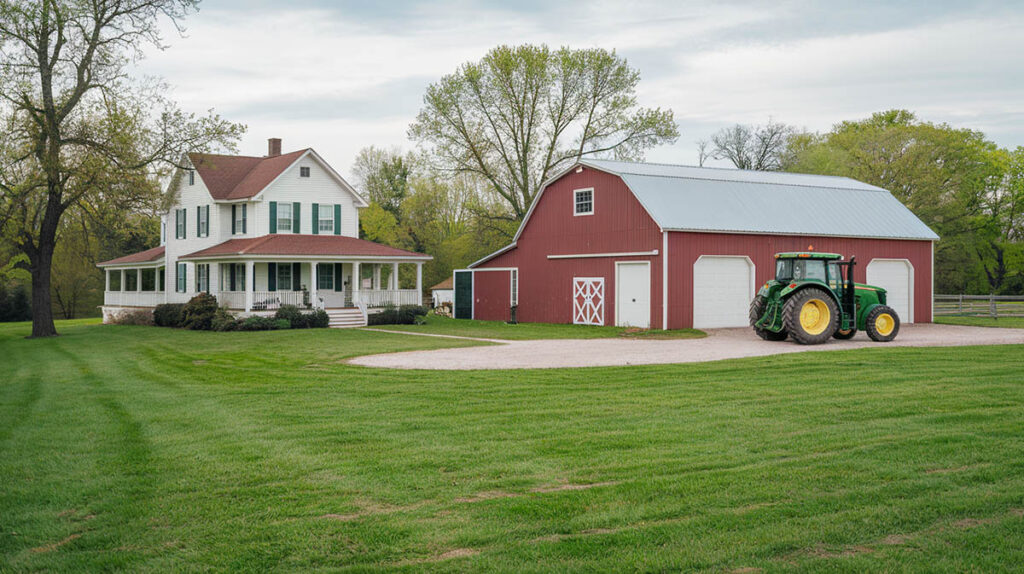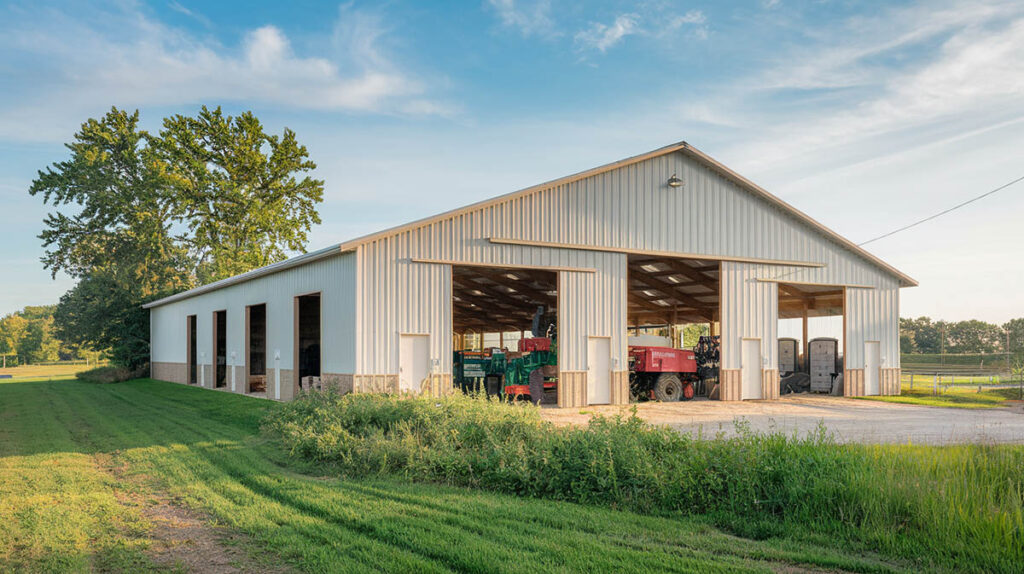Guide to Barn and Outbuilding Plans
So you’re thinking about adding a barn or outbuilding? I get it. Whether you need additional storage or workshop space, these versatile structures serve all kinds of useful purposes. If you invest time in thoughtful planning upfront, your building has a much better chance of being the perfect fit. So before pulling out the construction tools, let’s talk about practical considerations:

Determining the Primary Use
What will be the main purpose of your new barn structure? Will it house equipment, vehicles, or animals? Store hay, tools, or supplies? Or maybe you envision a workshop or multipurpose recreational space? Defining the primary function is goal number one, since that drives so many downstream decisions. You’ll also want to think carefully about size and layout.
Calculate the square footage you need now, but also look 5-10 years down the road. Trust me, it’s better to overestimate than limit future flexibility! Consider how you’ll circulate inside too. Having ample pathways for both people, animals and machinery will ensure the space remains accessible and useful over time.
Other key questions cover climate control needs, lighting, water access, doors, and any must-have amenities that support the building’s purpose. Addressing all these considerations upfront, even if it feels tedious, will pay off exponentially when it comes time to start framing those walls and raising that roof. Then you can feel confident your new barn or outbuilding will truly serve you well for years to come.
Space Planning
To help figure out what square footage is needed, consider the following:
- Equipment dimensions
- Storage requirements
- Working space needs
- Walking and circulation paths
- Future expansion needs
Legal and Site Considerations
Let’s start with the paperwork. Check in with your local zoning office to ensure structures like barns or sheds are allowed on your property. The last thing you want is to finish building only to be told it violates a code! Next, grab any required building permits.
Depending on the size and purpose of your structure, these may be mandatory. And don’t forget to research setback regulations so you meet the minimum distance from property lines your community requires. If you live in a historic district, there may be additional rules to follow as well so the character of the neighborhood is preserved.
Now let’s talk logistics. You’ll want to thoroughly evaluate your potential building site, especially since barns and outbuildings tend to be permanent structures. Start by testing the soil—this will determine what kind of foundation you need. Pay attention to drainage patterns too so you can manage water flow appropriately. And think carefully about access points to electricity, water lines, or other utilities.
Here are a few more things to ponder: Where does the sun rise and set on your property? Positioning your building to take advantage of natural light and warmth can be helpful. Are there prevailing winds or storms common in your area? If so, strategic placement may reduce damage risks down the road.
Legal and Site Considerations
Zoning laws and permits should be your first stop. Pop into the local zoning office or browse the municipal website to find out exactly what types of structures are allowed on your desired property. Whether you’ve got visions of a sleek modern masterpiece or a cozy cottage in mind, you’ll need to make sure it aligns with existing codes for that area regarding height, setbacks, and allowable uses. Don’t forget to figure permitting into your timeline too – those pesky inspectors will want to assess your electrical, plumbing, foundation plans, and more before signing off.
If your heart is set on a particular lot, determining any deed restrictions or historic district requirements is essential too. You don’t want to daydream about your perfect crafted bungalow only to discover no above-ground pools are allowed.
With bureaucracy handled, now the fun begins in evaluating your potential building site itself. Where and how do you want your home situated? Splurge on comprehensive soil testing to uncover any instability or contamination. Assess the property’s drainage patterns to plan your landscape grading strategy and prevent flooding issues.
Consider solar angles to optimize sunlight or shade. Confirm access points for connecting vital utilities like water, electric, gas, and sewer lines. Account for factors like prevailing wind direction when orienting your floorplan for protection during storms. With smart site planning, you can avoid annoying problems down the road!
Popular Types of Barns and Outbuildings
When it comes to barns and outbuildings, you’ve got options! The type you choose likely depends on your budget, timeline, intended use and personal taste.

Pole barns are hugely popular because they check a lot of boxes. Built with poles embedded directly in the ground, they’re the most affordable and fastest to throw up. You can store equipment, vehicles, hay – you name it. Just bear in mind they prioritize function over form.
Post and beam barns elicit visions of traditional red barns dotted across pastoral landscapes. With timber frames joined by pegs, they’re built to stand the test of time. But their striking, iconic looks come at a cost – we’re talking a hefty price tag and longer construction period.
On the more modern end of the spectrum, prefabricated metal buildings offer expedited assembly and excellent durability thanks to their noncombustible steel components. Resistant to rot, rust and critters, they require little upkeep. They may not be as charming as wood, but they offer unbeatable utility.
Beyond these main types, you can customize outbuildings for specialized functions. Suppose you need spaces specifically for woodworking, equipment storage, livestock or potting sheds. In that case, the sky’s the limit on tailoring buildings to suit your property’s unique needs.
Key Design Elements
A lot goes into making a structure that will shelter animals or store equipment while withstanding years of use. The foundation sets the whole stage. Concrete slabs offer stability and ease, while pier or floating options allow more airflow underneath. Frost walls and full or partial basements provide warmer spaces for animals in cold climates. Choose based on your location, climate and long-term plans.
Once the foundation is laid, start framing. The style of roof, gables and trusses impact overall load capacity to resist wind, rain and snow. Factor local weather and potential natural disasters into bracing requirements. Plan where to integrate expansion joints to accommodate natural material movement. Map locations for doors, windows and storage areas at this stage too.
Ventilation and climate control are central in this enclosed environment. Strategically balance fresh air flow with insulation needs, mechanical systems and natural lighting. Stop moisture buildup through site grading, drainage and vapor barriers to prevent mold or rot issues over time. With some planning during building, you can create ideal habitat tailored to your purposes, region and budget.
Material Selection
It’s important to choose the right materials for a durable structure that lasts for years. For structural support, lumber, such as 2x4s and 2x6s, are popular options to use. Engineered woods, like LVL beams and OSB sheathing have a lot of strength and are good for preventing warping. Steel components offer incredible durability for major structural elements. On the other hand, concrete blocks and posts bring rugged stability. Composite lumber products resist rot and insects. It’s a good idea to talk it over with a local builder to determine what best fits your budget and building conditions.
The exterior choices contribute greatly to the look and weather resistance of your barn. Classic vertical metal siding provides an iconic country look with modern durability. Natural wood siding offers rustic aesthetics but requires regular upkeep. For minimal maintenance, composite wood-plastic panels emulate wood while resisting moisture. Masonry exteriors like brick bring timeless elegance. And don’t forget roofing – standing seam metalroofing offers long-lasting performance in many color choices.
Inside your structure, wall, ceiling and flooring treatments impact aesthetics and functionality. Wall options like tongue and groove boards or plywood panels offer budget-friendly rustic finishes. Suspended ceiling panels allow access to utilities while reflecting light. Durable poured concrete floors stand up to heavy use and equipment. Storage solutions like cabinetry, overhead doors, and custom racks tailor the space to your needs. Finally, ample lighting ensures the interior remains bright, safe and usable in all conditions.
Safety Concerns
When designing barns and outbuildings, functionality and safety should be top priorities. Electrical, plumbing, HVAC, communication, and security systems need ample forethought to handle utility requirements now and in the future. Consider installing 200 amp electrical service with plenty of outlets, water lines and drains for wash areas, ventilation and climate control systems, intercoms or cameras for communication, and lighting or alarms to secure equipment and livestock. Plan ahead for possible expansions down the road.
Safety features also deserve special attention. Include smoke detectors, AEDs, exit signs over large doors, a lightning protection system, first aid kits stationed in multiple locations, and motion sensor lights on the exterior. Also research fire retardant building materials as an extra protective measure.
The ideal barn or outbuilding maximizes usefulness while minimizing risk. Investing a little extra time on the front end of infrastructure and hazard precautions can prevent major headaches later on. Approach designs with the flexibility to adapt over decades of changing needs. A well-designed support building improves farm functionality, organization and emergency preparedness overall.
Cost Planning
Proper cost planning is essential to avoid budget pitfalls down the road. The initial expenses can pile up quickly – those materials, equipment rentals, and professional contractor fees add up fast. Don’t forget about permits, site preparation, bringing in utilities, and other unexpected initial costs.
It’s not just the upfront costs you must worry about. Once the site is operational, the long-term costs continue. Maintenance and repairs will be necessary to keep things running smoothly. Energy bills, insurance premiums, supplies and other operating expenses can drain budgets over time. Planning ahead for major replacement projects in the years to come is also smart financial management.
Savvy managers set up dedicated reserve funds and sinking funds to save for big ticket maintenance and repairs. Replacing that HVAC system in 10 years or resurfacing the parking lot in 15 will cost you. Building owners also need the proper insurance coverage. It’s not exciting, but comprehensive general liability and property insurance is essential.
Construction Process
Choose an experienced contractor suited to the job, procure all necessary materials ahead of time, and pencil in tentative timelines for each phase, factoring in potential weather delays.
Once the blank canvas of your site is cleared and leveled, the real building begins. Watch with wonder as concrete is poured and cured to form a sturdy foundation upon which wooden wall frames are constructed. Roof trusses go up, followed by exterior siding and roofing to seal the structure from the elements. The finishing touches involve interior partitions, flooring, lighting fixtures and utility hookups to electricity, plumbing and HVAC systems.
To keep your new building looking its best for years to come, perform walkthrough inspections seasonally, maintaining interior cleanliness and watching for any structural issues needing attention. Annual preventative maintenance helps extend the life of equipment and systems, while routine upkeep like painting or staining maintains exterior surfaces against weathering. By staying vigilant, your barn or outbuilding will remain a functional, beautiful addition to your property for generations.
